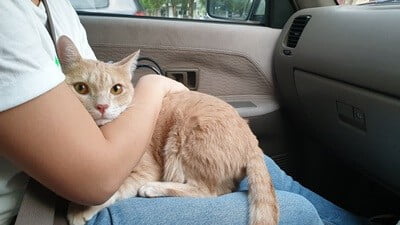Most cats dislike car rides, no matter how many they’ve experienced. Cars are loud, jostling, smell unfamiliar, and usually lead to an uncomfortable vet visit. This can make car rides stressful for cats, causing them to hiss, meow constantly, and breathe with their mouths open. So, it’s natural to seek out a way to calm your cat down.
Calm your cat during a car trip by sitting next to it, so it can see and smell you. Talk to the cat softly, so it can hear your voice. Some cats need their carriers veiled in a blanket to block out stimuli so that they don’t panic. Other cats benefit from calming music or pheromone sprays.
A vet can prescribe a sedative to calm your cat during car rides if needed. However, most cats learn to relax if you give them a chance to grow accustomed to the carrier and the car ahead of time. Give your cat 1-2 weeks to explore the carrier before the trip, and fill the space with its favorite toys and bedding. You can then perform a practice run.
Why Do Cats Hate Car Rides?
A car ride offers nothing fun for a cat. To make matters worse, cats are territorial and dislike leaving their territory.
The blaring horns and revving engines, strange people, and even stranger smells aren’t a pleasant experience for a cat that’s used to familiar voices, faces, and scents.
Even if the cat has traveled in a car before, it likely didn’t have a pleasant experience. Perhaps the cat was moved to a new house, with new sights and sounds to be wary of.
Maybe the cat was escorted to the vet, where it was poked, prodded, and surrounded by new faces. This can lead to a cat associating bad experiences with a car ride.
Car rides are stressful because they disrupt your cat’s set routine. They’re even more unexpected and unpleasant if you spring the carrier on the cat at the last moment.
Moreover, cats are smart enough to detect stress or apprehension in their owners. If you’re anxious about traveling with your cat, it’s likely to reflect that same emotion.
Symptoms of Cat Anxiety in a Car
Cats often feel anxious while traveling, so you might think your cat is hyperventilating.
Many owners believe putting a cat in the car is harmful since it may start breathing with an open mouth, drooling and panting, or meowing constantly. At the very least, the cat may be crying or yowling.
While these are signs of anxiety, they’re not deadly, nor do they indicate your feline has harmed itself.
These are natural indicators that your cat hates the car and is feeling anxious:
- Extreme duress/agitation
- Excessive salivation
- Nausea & vomiting
- Trembling
- Attempting to escape
- Yowling/loud meowing
- Panting
- Scratching at the carrier
- Soiling the carrier bedding
- Unwarranted aggression/hissing
Regardless of the symptoms your cat displays, feline anxiety is never a pleasant experience for your cat (or you). Being afraid will not harm the cat, but you’ll naturally want to help it feel more comfortable and calm.
What To Do When Your Cat Is Freaking Out In The Car
Let’s say that you’ve tried placing your cat in the vehicle, and it freaked out. This may be with or without a carrier. If you have time to spare, here are ways to help your cat react more calmly:
Choose a Comfortable Cat Carrier
Your road to success will start with choosing the right car carrier.
It should be a roomy box durable enough to hold your struggling cat. Don’t get a carrier that your cat can easily break out of or damage with its claws.
Carriers made from harder materials are ideal for aggressive felines. If you happen to own a more docile cat, you can opt for using a soft-sided mesh carrier.
The carrier needs to be big enough for your cat to stand up and turn around easily. Resist the urge to get the largest carrier, though, since cats feel safer in small spaces.
Introduce Your Cat to the Carrier
You can counter your cat’s anxiety by introducing it to the carrier before using it.
According to Applied Animal Behaviour Science, carrier-training cats will reduce their stress during the ride. Don’t keep the box away until the last moment, and expect your cat to adjust to the new smell and unfamiliar surface right away.
Here’s how to get your cat used to a carrier:
- Leave the carrier out in your living space for 1-2 weeks before the trip.
- Let your cat get used to it, sniff it, climb inside it, and so on.
- Keep one of your cat’s favorite toys or blankets inside the carrier to encourage sniffing.
- Give your cat treats every time they show an active interest in the carrier to create a positive association with it.
You won’t always know when you’ll need the carrier, especially in case of emergency vet visits. You must acquaint your pet with the carrier periodically.
If you have a cat on your hands, familiarize it with the box before any anxiety or fear sets in. Allowing the cat to explore the carrier will give rise to feelings of familiarity, comfort, and safety.
Introduce Familiar Smells in the Carrier and Car
Cats feel comfortable in spaces that smell and feel familiar. Introducing them to the carrier before the trip will help smoothen out their ride.
However, you can go one step further and add your cat’s favorite toys, familiar bedding, or blanket into the carrier to create a safe-smelling environment for it.
Additionally, you can use a soft cloth to wipe your cat’s face and then wipe the inside of the carrier with it. This will spread its scent around the area and make the carrier seem familiar.
You can even get artificial pheromones to ease your cat’s anxiety. Mist pheromone-replicating sprays inside the carrier and your car to make your cat feel relaxed and secure.
You can achieve the same result with pheromone collars and wipes.

Tire Your Cat Out Before the Trip
If you have a planned car trip or vet’s visit coming up, be sure to tire your cat out right before traveling.
Make the cat exert all its energy by playing with it. This can include making your cat chase after its favorite toys and running around after it until it’s tired.
This will ensure the cat is far more likely to get inside the carrier without resisting or acting out. Moreover, it might even sleep on the way to the vets.
Offer a Light Meal
If you already know your travel schedule, give your cat a light meal before getting into the car. This will reduce the risk of motion sickness and ensure that your cat doesn’t need to use the litter tray too often.
Watch Out for Motion Sickness
Moreover, watch out for signs of motion sickness, such as drooling, vomiting, or crying.
If you suspect motion sickness is the culprit behind your cat’s anxiety, seek appropriate medication from the vet before your next traveling adventure.
Medicinal Remedies to Calm Your Feline
It’s possible to use a cat sedative for traveling in the car. These sedatives or tranquilizers are prescribed by your vet and can be used to help your cat unwind or even fall asleep for the duration of the ride. There are also over-the-counter pheromone sprays that can help relax your cat.
However, when using medicine to treat your cat’s traveling-related anxiety, consult with your vet first. You cannot give your cat medicines designed for human use. Speaking to your vet will allow the expert to prescribe you cat-specific medication and ensure the dosage is right.
Merely schedule an appointment or speak with your vet over the phone to ask, “What can I give my cat to sleep in the car?” Most vets will prescribe medication if the cat’s anxiety is destructive to the feline.
Practice Run
Perform a practice run with your cat before the car trip. It’s important if you’re planning a road trip with your feline.
You can also turn off the engine and let your cat explore the inside of your car. Just be sure to keep the windows and doors closed.
Once the cat is used to the environment, you can put it back inside the carrier. Don’t drive your car when the cat is outside its carrier. It’s not safe for either of you, and you don’t want your cat to get used to it.
How To Calm An Anxious Cat In The Car
When it’s time to pack a cat into the vehicle, we don’t always have time to spare.
Perhaps you need to escort the feline to the vet, or you’re moving house. No matter the case, here are ways to help your cat feel more at ease, even if it hasn’t had the transition period described above:
Remain Seated Next to Your Cat
Since your cat will be stressed out by the unfamiliar atmosphere and sounds on the road, it will seek comfort in your presence. Seat yourself next to your cat’s carrier if you’re not in the driving seat.
If you’re driving the car, put the carrier where your cat can easily see you. It will calm your cat down during traveling.
If you’re sitting next to the carrier, you can place your hand on it. However, don’t take your cat out of the carrier. You don’t want an anxious, scared, or agitated cat jumping out of the box and hiding near the brake pedal.
Talk to Your Cat and Pet It
The best thing you can do for a scared cat is talk to it. Most cats find their owner’s voice reassuring due to the familiarity. Try speaking to your cat in a soft, gentle tone and see how it responds.
Moreover, if your cat loves to be petted, you can stroke it from outside its carrier. There may be space between the bars or when you push against the mesh of the carriers. Your familiar touch might have a relaxing effect on your cat.
Play Species-Appropriate Music in the Car
According to Louisiana State University, cats calm down when listening to cat-centric or species-appropriate music.
This type of music includes cat vocalizations, such as suckling and purring. It has proven to be the most effective sound in reducing felines’ stress levels.
Cats also like music with a beat similar to their resting heart rate. If you have such music playing in the car, your cat might respond positively and calm down.
Drive Sensibly
When you have your cat in the car with you, drive sensibly. Your cat might feel anxious due to sudden movements. Avoid potholes and road bumps as much as possible, and keep your eyes peeled for those speed bumps.
Likewise, make sure the cat carrier is securely tied to the seat to prevent it from bouncing or sliding. After all, if you encounter a sudden bump in the road, your cat will not be able to brace itself like you. You will need to take care of such eventualities for your cat.
Increase/Decrease Your Cat’s Visual Stimuli
Some cats need to be aware of their surroundings and see outside to be able to calm down, and others need to be sheltered and have limited visibility to remain calm.
If your feline is curious, place its carrier in a way that allows it to see out the window. If you own a timid cat, place a cover over it to protect against needless visual stimuli. You can use a towel or a light blanket to cover the carrier.
Watch the Temperature Carefully
Be mindful of the outside temperature and set your car’s internal temperature accordingly. You need to maintain a comfortable range to ensure your cat isn’t also stressed out by excess cold or heat.
Depending on the time of the year, keep the AC or heater running, but don’t aim the vents directly at your cat. The direct temperature change may be upsetting for cats, as can the noise of the fan and the air current.
Avoid Pit Stops
If possible, go directly to your destination without making stops. The sooner this car ride is over, the better your cat will feel. Aside from that, the car’s internal temperature will quickly heat up or cool down when exposed to the outside environment.
If you have to take breaks, make sure your cat is with someone reliable while you’re away from the carrier. If you notice your cat panting in the car due to the heat, amp up the AC and provide the kitty with cool drinking water.

How to Transport a Cat in a Car without a Carrier
Does a cat need to be in a carrier in the car? Not exactly. There are 5 different ways to secure your cat in the vehicle that doesn’t require you to buy (and familiarize your cat with) a special carrier.
The carriers merely ensure it’s easier to pack the feline around and contain some of the mess, should your feline react out of fear in the car.
The important part is ensuring your cat is secured within the vehicle. If it can move around, it’s likely to be jostled during the ride, make messes, and even play around with the foot pedals.
Cat Harness
Cat owners typically use harnesses when walking with their cats. However, if you need to travel with your cat in an emergency, you can use a harness instead of a carrier.
Ensure that your cat is used to the harness. Attach it to your feline before taking it out to the car. Keep some treats handy if you need to create positive associations. Also, get a quality harness that your cat doesn’t break out of easily.
Sports Bag
If you don’t have a carrier or a harness, you can use a sports bag to carry your cat.
Make sure the bag is well-ventilated and has a smooth base. This will make your cat comfortable as it sits inside the bag. You can also add your cat’s favorite toy and blanket inside the bag to make it more accommodating.
Cardboard Box
You can also use a cardboard box as a makeshift carrier for your cat. Just don’t forget to secure it properly with masking tape if needed. Also, ventilate the box and add your cat’s blanket inside it before putting your cat in the box.
Laundry Basket
You can also use a sturdy plastic laundry basket with holes in it to carry your cat to the vet.
Make sure that the basket is big enough for your cat to sit and stand inside it. You can make your cat feel comfortable in the basket by putting its favorite bedding inside it and using a pheromone spray on it.
Old Purse
If you’re truly out of options, you can use an old purse to carry your cat. Put enough holes in it for ventilation. Also, choose a purse that is big enough to house your car comfortably. Try to choose a sturdy option.
Most cats will never like a car ride. However, there are ways to ensure your feline calms down in the vehicle and accepts the ride with as much grace as possible.
Just be sure to act patiently and compassionately with the cat. Your presence and mood will affect how quickly your cat stops freaking out in the car.

